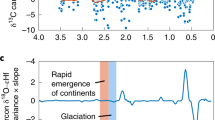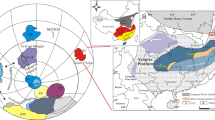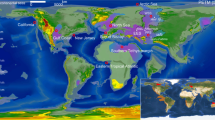Abstract
A hallmark of the rapid and massive release of carbon during the Palaeocene–Eocene Thermal Maximum is the global negative carbon isotope excursion. The delayed recovery of the carbon isotope excursion, however, indicates that CO2 inputs continued well after the initial rapid onset, although there is no consensus about the source of this secondary carbon. Here we suggest this secondary input might have derived partly from the oxidation of remobilized sedimentary fossil carbon. We measured the biomarker indicators of thermal maturation in shelf records from the US Mid-Atlantic coast, constructed biomarker mixing models to constrain the amount of fossil carbon in US Mid-Atlantic and Tanzania coastal records, estimated the fossil carbon accumulation rate in coastal sediments and determined the range of global CO2 release from fossil carbon reservoirs. This work provides evidence for an order of magnitude increase in fossil carbon delivery to the oceans that began ~10–20 kyr after the event onset and demonstrates that the oxidation of remobilized fossil carbon released between 102 and 104 PgC as CO2 during the body of the Palaeocene–Eocene Thermal Maximum. The estimated mass is sufficient to have sustained the elevated atmospheric CO2 levels required by the prolonged global carbon isotope excursion. Even after considering uncertainties in the sedimentation rates, these results indicate that the enhanced erosion, mobilization and oxidation of ancient sedimentary carbon contributed to the delayed recovery of the climate system for many thousands of years.
This is a preview of subscription content, access via your institution
Access options
Access Nature and 54 other Nature Portfolio journals
Get Nature+, our best-value online-access subscription
$29.99 / 30 days
cancel any time
Subscribe to this journal
Receive 12 print issues and online access
$259.00 per year
only $21.58 per issue
Buy this article
- Purchase on Springer Link
- Instant access to full article PDF
Prices may be subject to local taxes which are calculated during checkout




Similar content being viewed by others
Data availability
The authors declare that the data supporting the findings of this study are available within the paper and its Supplementary Information files. Additional source data for Fig. 4 is available upon reasonable request.
References
Zachos, J. C., Dickens, G. R. & Zeebe, R. E. An early Cenozoic perspective on greenhouse warming and carbon-cycle dynamics. Nature 451, 279–283 (2008).
McInerney, F. A. & Wing, S. L. The Paleocene–Eocene Thermal Maximum: a perturbation of carbon cycle, climate, and biosphere with implications for the future. Annu. Rev. Earth Planet. Sci. 39, 489–516 (2011).
Kennett, J. P. & Stott, L. D. Abrupt deep-sea warming, palaeoceanographic changes and benthic extinctions at the end of the Palaeocene. Nature 353, 225–229 (1991).
Sluijs, A. et al. Environmental precursors to rapid light carbon injection at the Palaeocene/Eocene boundary. Nature 450, 1218–1221 (2007).
Zachos, J. C. et al. A transient rise in tropical sea surface temperature during the Paleocene–Eocene Thermal Maximum. Science 302, 1551–1554 (2003).
Gutjahr, M. et al. Very large release of mostly volcanic carbon during the Palaeocene– Eocene Thermal Maximum. Nature 548, 573–577 (2017).
Dunkley Jones, T. et al. Climate model and proxy data constraints on ocean warming across the Paleocene–Eocene thermal maximum. Earth Sci. Rev. 125, 123–145 (2013).
Zeebe, R. E., Ridgwell, A. & Zachos, J. C. Anthropogenic carbon release rate unprecedented during the past 66 million years. Nat. Geosci. 9, 325–329 (2016).
Cui, Y. et al. Slow release of fossil carbon during the Palaeocene–Eocene Thermal Maximum. Nat. Geosci. 4, 481–485 (2011).
Zeebe, R. E., Zachos, J. C. & Dickens, G. R. Carbon dioxide forcing alone insufficient to explain Palaeocene–Eocene Thermal Maximum warming. Nat. Geosci. 2, 576–580 (2009).
Frieling, J. et al. Thermogenic methane release as a cause for the long duration of the PETM. Proc. Natl Acad. Sci. USA 113, 12059–12064 (2016).
Bowen, G. J. Up in smoke: a role for organic carbon feedbacks in Paleogene hyperthermals. Glob. Planet. Change 109, 18–29 (2013).
Kirtland Turner, S. & Ridgwell, A. Development of a novel empirical framework for interpreting geological carbon isotope excursions, with implications for the rate of carbon injection across the PETM. Earth Planet. Sci. Lett. 435, 1–13 (2016).
Hilton, R. G., Galy, A., Hovius, N., Horng, M. J. & Chen, H. Efficient transport of fossil organic carbon to the ocean by steep mountain rivers: an orogenic carbon sequestration mechanism. Geology 39, 71–74 (2011).
Bouchez, J. et al. Oxidation of petrogenic organic carbon in the Amazon floodplain as a source of atmospheric CO2. Geology 38, 255–258 (2010).
John, C. M. et al. Clay assemblage and oxygen isotopic constraints on the weathering response to the Paleocene–Eocene Thermal Maximum, east coast of North America. Geology 40, 591–594 (2012).
Baczynski, A. A. et al. Distortion of carbon isotope excursion in bulk soil organic matter during the Paleocene–Eocene thermal maximum. GSA Bull. 128, 1352–1366 (2016).
Carmichael, M. J. et al. Hydrological and associated biogeochemical consequences of rapid global warming during the Paleocene–Eocene Thermal Maximum. Glob. Planet. Change 157, 114–138 (2017).
Schneider-Mor, A. & Bowen, G. J. Coupled and decoupled responses of continental and marine organic-sedimentary systems through the Paleocene–Eocene Thermal Maximum, New Jersey margin, USA. Paleoceanography 28, 105–115 (2013).
Handley, L., Pearson, P. N., McMillan, I. K. & Pancost, R. D. Large terrestrial and marine carbon and hydrogen isotope excursions in a new Paleocene/Eocene boundary section from Tanzania. Earth Planet. Sci. Lett. 275, 17–25 (2008).
Self-Trail, J. M., Powars, D. S., Watkins, D. K. & Wandless, G. A. Calcareous nannofossil assemblage changes across the Paleocene–Eocene Thermal Maximum: evidence from a shelf setting. Mar. Micropaleontol. 92–93, 61–80 (2012).
Edwards, L. E. Dinocyst taphonomy, impact craters, cyst ghosts and the Paleocene–Eocene Thermal Maximum (PETM). Palynology 36, 80–95 (2012).
Eglinton, G. & Hamilton, R. J. in Chemical Plant Taxonomy (ed. Swain, T.) 187–217 (Academic, Cambridge, 1963).
Meyers, P. A. Organic geochemical proxies of paleoceanographic, paleolimnologic, and paleoclimatic processes. Org. Geochem. 27, 213–250 (1997).
Peters, K. E., Walters, C. C. & Moldowan, J. M. The Biomarker Guide Vols 1 and 2 (Cambridge Univ. Press, Cambridge, 2005).
Freeman, K. H. & Pancost, R. D. in Treatise on Geochemistry 2nd edn (eds Holland, H. D. & Turekian, K. K.) Vol. 12, 395–416 (Elsevier Inc., Amsterdam, 2013).
Bralower, T. J. et al. Evidence for shelf acidification during the onset of the Paleocene–Eocene Thermal Maximum. Paleoceanogr. Paleoclimatol. https://doi.org/10.1029/2018PA003382 (2018).
Popp, B. N. et al. Effect of phytoplankton cell geometry on carbon isotopic fractionation. Geochim. Cosmochim. Acta 62, 69–77 (1998).
Fogel, M. L. & Cifuentes, L. A. in Organic Geochemistry. Topics in Geobiology Vol. 11 (eds Engel, M. H. & Macko S. A.) 73–98 (Springer, Boston, 1993).
Bidigare, R. R. et al. Consistent fractionation of 13C in nature and in the laboratory: growth-rate effects in some haptophyte algae. Global. Biogeochem. Cycles 11, 279–292 (1997).
Pancost, R. D., Freeman, K. H., Wakeham, S. G. & Robertson, C. Y. Controls on carbon isotope fractionation by diatoms in the Peru upwelling region. Geochim. Cosmochim. Acta 61, 4983–4991 (1997).
Freeman, K. H. & Pagani, M. in A History of Atmospheric CO 2 and its Effects on Plants, Animals, and Ecosystems. Ecological Studies Vol. 177 (eds Baldwin, I. et al.) 35–61 (Springer, New York, 2005).
Summons, R. E., Jahnke, L. L., Hope, J. M. & Logan, G. A. 2-Methylhopanoids as biomarkers for cyanobacterial oxygenic photosynthesis. Nature 400, 554–557 (1999).
Guy, R. D., Fogel, M. L. & Berry, J. A. Photosynthetic fractionation of the stable isotopes of oxygen and carbon. Plant Physiol. 101, 37–47 (1993).
Sakata, S. et al. Carbon isotopic fractionation associated with lipid biosynthesis by a cyanobacterium: relevance for interpretation of biomarker records. Geochim. Cosmochim. Acta 61, 5379–5389 (1997).
Sinninghe Damsté, J. S., Rijpstra, W. I. C., Dedysh, S. N., Foesel, B. U. & Villanueva, L. Pheno- and genotyping of hopanoid production in Acidobacteria. Front. Microbiol. 8, 1–20 (2017).
Malinconico, M. L. Thermal maturity of the middle Atlantic coastal plain: South Dover Bridge core (MD) and Taylor #1 stratigraphic test well (VA). GSA Contract Rep. 53, 1689–1699 (2009).
Malinconico, M. L. & Weems, R. E. Thermal Maturity of the U. S. Atlantic Coastal Plain Based on Legacy Exploration and Stratigraphic Test Wells, Including Hatteras Light Esso #1 Search and Discovery Article no. 50317 (AAPG, 2010).
Seifert, W. K. & Moldowan, J. M. The effect of thermal stress on source-rock quality as measured by hopane stereochemistry. Phys. Chem. Earth 12, 229–237 (1980).
Moldowan, J. M., Seifert, W. K. & Gallegos, E. J. Relationship between petroleum composition and depositional environment of petroleum source rocks. Am. Assoc. Pet. Geol. Bull. 69, 1255–1268 (1986).
Mackenzie, A. S., Patience, R. L. & Maxwell, J. R. Molecular parameters of maturation in the Toarcian shales, Paris Basin, France—I. Changes in the configurations of acyclic isoprenoid alkanes, steranes and triterpanes. Geochim. Cosmochim. Acta 44, 1709–1721 (1980).
Tappert, R., Mckellar, R. C., Wolfe, A. P. & Ortega-blanco, J. Stable carbon isotopes of C3 plant resins and ambers record changes in atmospheric oxygen since the Triassic. Geochim. Cosmochim. Acta 121, 240–262 (2013).
Kopp, R. E. et al. An Appalachian Amazon? Magnetofossil evidence for the development of a tropical river-like system in the mid-Atlantic United States during the Paleocene–Eocene Thermal Maximum. Paleoclimatology 24, 1–17 (2009).
Galy, V., Peucker-Ehrenbrink, B. & Eglinton, T. Global carbon export from the terrestrial biosphere controlled by erosion. Nature 521, 204–207 (2015).
Trampush, S. M. & Hajek, E. A. Preserving proxy records in dynamic landscapes: modeling and examples from the Paleocene–Eocene Thermal Maximum. Geology 45, 967–970 (2017).
Handley, L. et al. Changes in the hydrological cycle in tropical East Africa during the Paleocene–Eocene Thermal Maximum. Palaeogeogr. Palaeoclimatol. Palaeoecol. 329, 10–21 (2012).
Kelly, D. C., Zachos, J. C., Bralower, T. J. & Schellenberg, S. A. Enhanced terrestrial weathering/runoff and surface ocean carbonate production during the recovery stages of the Paleocene–Eocene Thermal Maximum. Paleoceanography 20, 1–11 (2005).
Self-Trail, J. M. et al. Shallow marine response to global climate change during the Paleocene–Eocene Thermal Maximum, Salisbury Embayment, USA. Paleoceanography 32, 710–728 (2017).
Parrish, J. T. Latitudinal distribution of land and shelf and absorbed solar radiation during the Phanerozoic. USGS Open-File Rep. 85-31, 1–21 (1985).
Armitage, J. J., Whittaker, A. C., Zakari, M. & Campforts, B. Numerical modelling of landscape and sediment flux response to precipitation change. Earth. Surf. Dynam. 6, 77–79 (2018).
Acknowledgements
Funding for this study was provided by National Science Foundation grant no. CE-1416663. We acknowledge discussions with M. Robinson, K. Hantsoo and J. A. Grey. We are grateful to D. Walizer for analytical support. Any use of trade, firm or product names is for descriptive purposes only and does not imply endorsement by the US Government.
Author information
Authors and Affiliations
Contributions
S.L.L., A.A.B., E.G.P. and J.R.V. carried out the organic isotope analyses, S.L.L. and A.A.B. carried out the biomarker analyses, S.L.L. interpreted the biomarker and isotope data, T.L.B. and J.C.Z. conducted and interpreted the carbonate isotope analyses, J.M.S.-T. determined the sedimentation rates, S.L.L. and E.A.H. designed the mixing model, K.H.F., J.C.Z., S.M.T., L.R.K., T.J.B. and A.A.B. contributed to major improvements within the models and data interpretation, S.L.L. wrote the paper, and all the authors contributed to interpreting the data and editing the paper. K.H.F. advised the direction of the research.
Corresponding author
Ethics declarations
Competing interests
The authors declare no competing interests.
Additional information
Publisher’s note: Springer Nature remains neutral with regard to jurisdictional claims in published maps and institutional affiliations.
Supplementary Information
Supplementary Information
Supplementary Methods, Tables and Figures.
Supplementary Data
Supplementary Data Set.
Rights and permissions
About this article
Cite this article
Lyons, S.L., Baczynski, A.A., Babila, T.L. et al. Palaeocene–Eocene Thermal Maximum prolonged by fossil carbon oxidation. Nature Geosci 12, 54–60 (2019). https://doi.org/10.1038/s41561-018-0277-3
Received:
Accepted:
Published:
Issue Date:
DOI: https://doi.org/10.1038/s41561-018-0277-3
This article is cited by
-
Benthic foraminiferal turnover and trait changes across the Palaeocene–Eocene Thermal Maximum (PETM) at ODP site 1265A, Walvis Ridge, SE Atlantic Ocean
Arabian Journal of Geosciences (2023)
-
Clay hydroxyl isotopes show an enhanced hydrologic cycle during the Paleocene-Eocene Thermal Maximum
Nature Communications (2022)
-
New findings on Stratigraphy of the Paleocene–early Eocene successions in Lorestan Zone, Iran
Carbonates and Evaporites (2022)
-
Floodplain evolution during the early Paleogene within the Piceance Creek Basin, northwest Colorado, U.S.A
Journal of Sedimentary Environments (2022)
-
Mountains, erosion and the carbon cycle
Nature Reviews Earth & Environment (2020)



